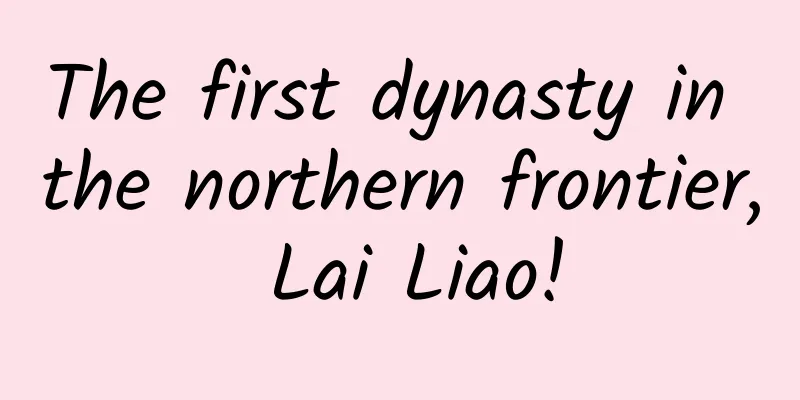The first dynasty in the northern frontier, Lai Liao!

|
Of course you know Song It is the main character of the "Tang, Song, Yuan, Ming and Qing Dynasties" in history textbooks. This is the era when Chinese culture reached its peak (Historian Chen Yinke) ▼ "The culture of the Chinese nation has evolved over thousands of years. It reached its peak during the Zhao and Song dynasties.” But at the same time as this elegant dynasty A nomadic regime entrenched in northern China Liao , how much do you know? Heyday It has been on par with the Song Dynasty for a hundred years The territory stretches from the Sea of Japan in the east to the Altai Mountains in the west. "China" in Russian is still the transliteration of Khitan "Китай" (Please watch in horizontal mode, Liao territory diagram, map by @Zheng Yi/Planetary Research Institute) ▼ This is the other side of China There is a vast world, freedom like the wind Give birth to brave men and heroic women (The Wulanbutong grassland in Chifeng, Inner Mongolia gave birth to the Khitan people. The picture shows the horse racing in the snow at Wulanbutong. Image source: Visual China) ▼ Women are entering the political arena A big deal, a big show Creating the unique landscape of the Northern Dynasty (Fengguo Temple in Jinzhou, Liaoning, is a royal temple in the fiefdom of Empress Xiao’s family. The Bodhisattvas in the temple are young women. Photographer: Yao Peng) ▼ Two hundred years of being king of Saibei Eight thousand miles of vast territory What kind of Khitan children are they? Create such a magnificent dynasty But often absent from the public eye The tribesmen were exiled to other places, and their languages were difficult to understand. (Octagonal bronze mirror with Khitan script. People’s understanding of Khitan script is still limited. Photographer: @笑谈间气吐霓虹, map: @大廖萧田田/星球研究院) ▼ Let's go back to 907 AD The First Dynasty of Saibei Will be born in the bloody sunset of the Tang Dynasty 01 The Afterglow of the Tang Dynasty A genius who established a career - Yelu Abaoji In 907 AD, the glorious Tang Dynasty Experienced the Anshi Rebellion, eunuchs in power, and separatist regimes Already dying The last puppet emperor, the 15-year-old Emperor Ai of Tang, Li Chu , was deposed. The Bloody Sunset of the Tang Dynasty One by one, the vassal forces competed to establish themselves as kings Divide this huge dynasty It also dragged China into another chaotic period since the Wei, Jin, Southern and Northern Dynasties. Five Dynasties and Ten Kingdoms (A brief timeline of the Five Dynasties and Ten Kingdoms, drawn by @大廖萧田田/Planet Research Institute) ▼ The same year Emperor Ai of Tang was deposed An eagle cries loudly on the northern grassland 35-year-old Yelu Abaoji Unify the eight Khitan tribes and become the leader of the alliance He has sharp eyes and a sharp edge. Wherever the eyes are, wherever the blade points, the land of China (Situation diagram of the early Five Dynasties and Ten Kingdoms period, drawn by @郑艺/Planetary Research Institute) ▼ The two most powerful vassal forces in the late Tang Dynasty Liang Wang Zhu Wen and Jin Wang Li Keyong They all successively won over Yelu Abaoji In this chaotic time, no one underestimates this grassland force So here comes the question Khitan, where did you come from? How to get in? Northeast China The Xilamulun River , also known as the Huangshui River, originates from the Inner Mongolia Plateau. The Laoha River , also known as the Tuhe River, originates from the Qilaotu Mountains in Hebei Province. It converges into the Xiliao River in Chifeng, Inner Mongolia (Schematic diagram of the Liaohe River Basin water system and location, drawn by @Zheng Yi/Planet Research Institute) ▼ The Khitan legend was born here The tribe breeds here (In the Khitan legend of "Blue Ox and White Horse", a god rode a white horse eastward from the Futu River on Mayun Mountain, and a goddess drove a blue ox cart from the pine forest on the flat ground to the Huangshui River. When the two rivers merged at Muye Mountain, they met, became spouses, and gave birth to eight sons. Later, the tribe gradually prospered and was divided into eight tribes, which are the eight tribes of Khitan. The picture shows the Xilamulun River, which is the Huangshui River. The picture comes from @Visual China) ▼ Historically, forests and grasslands were interlaced here. The water plants are lush, the river is flowing, and the water is clear Khitan ancestors and ethnic groups living on the surrounding grasslands Live as a nomad together and roam the vast wilderness (Chifeng, Inner Mongolia, Wulanbutong Grassland, Photographer @李源) ▼ The difference between Chinese and barbarians is caused by favorable conditions of time and place The 400mm precipitation line divides you and me Nomads live wherever there is water and grass No fixed place to live on the grassland, tired from traveling by boat In order to be lighter, Khitan men, women and children often shaved their heads Shave all hair except the front of the head (Showing various types of Khitan shaved heads, drawn by @大廖萧田田/星球研究院) ▼ They wore felt boots and hoods. Fighting against wild beasts and facing the wind and frost Riding a horse and shooting for a living (Sketch of Khitan men's clothing, drawing by Liu Yonghua, drawing by Xiao Tiantian of the Liao Dynasty/Planetary Research Institute) ▼ The wilderness is also full of dangers There is no such thing as “no pain, no gain” here. Get prey, equip weapons, and plan actions Only the brave can lead the tribe to survive (Horse herders on the Ulanbutong grassland, photographer @Fuxiao718) ▼ The Han Chinese literature is plentiful. The Khitan people had elaborate and complex horse harnesses Since the Khitans mastered the iron smelting technology There are many kinds of arrows and the weapons are well equipped. Practicing horseback tricks, the art of military (Distribution diagram of Khitan horse harness accessories, drawn by @大廖萧田田/Planet Research Institute) ▼ Although there is no bureaucratic system developed in the Central Plains for thousands of years, The Khitan tribes were loosely organized, but also flexible and efficient. Whenever troops are dispatched, the leaders of each tribe need to discuss together This is for " raising troops and discussing " Men of the Khitan tribe were both soldiers and herdsmen Daily animal husbandry and hunting for a living In wartime, everyone is a soldier and fights on the battlefield A cavalry unit capable of fighting Gradually growing stronger in military operations (Please watch Wulanbutong driving horses in horizontal mode. There are many similarities between nomadic life and military operations. Photographer @陶洪) ▼ On the grassland, success and failure are equally cruel You finish your song, I will take the stage The Khitans were entangled between the surrounding Turks, Uighurs, and Goguryeo. Also came into direct contact with the Central Plains regime During the Zhenguan period of the Tang Dynasty, the Khitan surrendered to the Tang Dynasty Bow down to the prosperous Tang Dynasty (Yelü Bei's "Shooting Deer" was painted by Yelü Bei, the eldest son of Yelü Abaoji. Yelü Bei was deeply influenced by Confucian education and was quite good at painting. Image source @Wikimedia Commons) ▼ But two hundred years The Tang dynasty was on the decline, and the Uighurs were also caught in civil strife. The powerful neighbors around them have become corrupt one after another The Khitan cavalry continued to grow By the end of the Tang Dynasty, the Khitan had 300,000 elite soldiers and generals. War in the Central Plains, Vacuum in the Northern Desert The Khitans rose in the Five Dynasties But admission depends on hard power. (The Khitans established their country on military power and attached great importance to weapons and armaments. The picture shows a golden scabbard knife with a phoenix pattern. The photographer is @笑谈间气吐霓虹, and the map is @大廖萧田田/星球研究院) ▼ The powerful Khitan There is never a shortage of brave cavalry and archers. But how to go from a powerful nomadic tribe alliance Becoming a truly connected nation Khitan needs an ambitious and ambitious person 907 AD The day Yelu Abaoji became the Khitan Khan His brothers may not realize what this means yet. Yelu Abaoji was outstanding and stood out in military activities But according to convention, after three years The Khanship will also be open to them. (Gyeongju White Pagoda, Gyeongju is located in Balin Right Banner, Chifeng, Inner Mongolia, and is the site of the Khitan royal mausoleum. Photographer @赵云天) ▼ But they did not wait until Abaoji abdicated. Three years and three years Yelu Abaoji challenged the old customs of the Khitan tribe With the help of his wife Shulü Ping Repeatedly suppressing the unrest initiated by the brothers Yelu Abaoji must have been certain: Only I can lead the Khitan tribe to establish a country Under the Iron Throne is the blood of brothers In 916, Yelü Abaoji officially became emperor The country's name is " Khitan " (After founding the country, Yelu Abaoji ordered people to create Khitan characters. Khitan characters influenced the creation of characters of northern ethnic groups such as Jurchen, Xixia, and Mongolia. Khitan characters are translated into Chinese characters. Map by @Da Liao Xiao Tiantian/Planet Research Institute) ▼ After the founding of the People's Republic of China Yelu Abaoji crushed the enemy with overwhelming force Leading the Khitan to march east and west Head west , across thousands of miles of quicksand Arrived at the Altai Mountains in Xinjiang and the banks of the Erhun River in Mongolia Conquered many tribes including the Uighurs and Tatars (Summer landscape of the Chuya River Basin in the Altai Mountains, image source: Visual China) ▼ To the east , take a large piece of fertile land He personally led an army to conquer the "prosperous country in the east of the sea" Bohai Kingdom Expanding the territory to the coast of the Sea of Japan (Songhua River, the territory of Bohai State covers the Songhua River and Tumen River basins, and agriculture is developed within the territory. Photographer @陈剑峰) ▼ So far Most of China north of the Great Wall submitted to the Khitan (Tuotuo et al., History of Liao, Volume 1, Taizu Part 2) ▼ "From the sea in the east to the quicksand in the west and the desert in the north, its reputation stretches thousands of miles." Please note that The eagle flaps its wings and is ready to fly And its journey More than just grasslands and deserts 02 North-South confrontation Beauty Creates a Prosperous Era - Empress Dowager Xiao Chuo Unlike his predecessors Yelu Abaoji did not intend to limit his power to plundering. What he wanted was to establish a Han dynasty. There are grasslands and forests for nomadic life, fishing and hunting. There must also be land for agricultural development and strong cities. Khitan people, aiming at the Central Plains (Rice fields at the mouth of the Panjin River in Liaoning, for illustration only, photographer @焦潇翔) ▼ 936 AD The ruler of the Central Plains is the Li family of the Later Tang Dynasty This short-lived Second Five Dynasties The transfer of power always leads to internal strife The new emperor surrounded his general Shi Jingtang who was guarding Shanxi In a panic, Shi Jingtang asked the Khitan for help Propose to offer the northern border area In exchange for the Khitan uprising The Khitan iron hooves marched south along the Loess Plateau The Later Tang regime was defeated in one battle What you get in return is crucial Sixteen Prefectures of Youyun (Datong, Shanxi, was Yunzhou at that time, and later became the capital of Liaoxi, a major military town. Photographer: @董宏伟) ▼ This is the front and back of Taihang Mountain It is the gateway to the Central Plains and the center of northern border defense fortresses. If there were no Youyun area, the North China Plain would be flat. The Central Plains Dynasty had no strategic location to defend (Sketch of the Sixteen Prefectures of Youyun, drawn by @Zheng Yi/Planetary Research Institute) ▼ If the Khitan could continue to move south at this time How will history be written? But history cannot be assumed After the Khitan conquered the Sixteen Prefectures of Youyun The situation in the Central Plains is becoming clearer Chenqiao Mutiny, Yellow Robe Zhao Kuangyin seized the Later Zhou Dynasty and established the Northern Song Dynasty The Situation of China since the Late Tang Dynasty The fog gradually dissipated The confrontation between the North and the South becomes clearer (A diagram showing changes in China's situation from the 10th to the 12th century AD, courtesy of @郑艺/Planetary Research Institute) ▼ Seeing this, you may find Song was not the absolute ruler who unified the world Song and Liao On the battlefields of the north and south, each has his own abilities and opportunities. Meeting at the top, a worthy match Battle of Gaoliang River Emperor Taizong of Song, Zhao Guangyi, fled in a hurry on a donkey cart Khitan general Yelu Xiuguo was also injured After that, the Song and Liao sides were in a stalemate for decades. The frontier battle line has witnessed the heroic and tragic deeds of countless heroes The Yang family will enter the historical stage (Yanmen Pass after the snow, Yang Ye defeated the Liao army at Yanmen Pass, but later died of starvation due to the coercion of villains and lack of help. Yang Ye and his son Yang Yanzhao and grandson Yang Wenguang were collectively known as the "Yang Family Generals". Later generations developed the story of the Yang Family Generals into operas and storytelling. Photographer @杨东) ▼ How to break the deadlock? Should we continue to fight or make peace? The fate of Khitan lies in the hands of a widowed woman When her husband Yelu Xian died, Xiao Chuo was about 30 years old. Like most of the previous Khitan queens, she From the Xiao family Unlike the Central Plains dynasties, which were wary of foreign relatives interfering in politics The special marriage tradition of the Khitan royal family It established that the Queen's family was deeply involved in Khitan politics (History of Liao Dynasty: Biographies of Empresses and Concubines) ▼ "The Liao people regarded saddle horses as their home, and their empresses and concubines were often good at archery and charioteering, and they never failed to accompany the army in hunting." Yelu Xian was weak and sickly since childhood. Before her husband's death Xiao Chuo has already gone to court to deal with military and political affairs Yelu Xian specifically instructed his subjects "When writing down the Queen's words, you should also use '朕' or '我'" (Fengguo Temple in Jinzhou, Liaoning Province, is said to have been built by Emperor Shengzong of Liao at the order of Empress Xiao, who is better known as Empress Xiao. Photographer: Li Wenbo) ▼ This is a wise female politician. Govern the country well and distinguish rewards and punishments clearly Gained strong support from civil and military ministers at the court With other tribes watching closely Xiao Chuo maintained the Khitan's stable political situation for more than ten years She may not have to go through the harsh public opinion faced by female rulers in the Central Plains. But there are still difficult political choices to make But the relationship between Song and Liao It has reached a critical point (Chanzhou is located in Puyang, Henan Province today. The picture shows the Puyang Sipailou. Photographer: @刘辰) ▼ Chanzhou City in 1004 Xiao Chuo, who was over 50 years old, took her son with her and planned Song Zhenzong, who had lived in the palace for a long time, was reluctant to give in under the insistence of his ministers. Both the Song and Liao sides are at the gates of the city, and it is a matter of life and death. At the critical moment The scales of history have tilted slightly towards peace Song and Liao both took a step back Known in history as the " Chanyuan Alliance " (Main content of the Chanyuan Alliance between Song and Liao, drawn by @Zheng Yi & Xiao Tiantian of the Liao Dynasty/Planetary Research Institute) ▼ Although the Khitans had cavalry, they might not have an advantage if they went south. Although Song was weak militarily, it had the support of the vast south. Neither the Song nor the Liao could easily defeat the other side. The Chanyuan Alliance was the result of the two sides being evenly matched. Rational and careful consideration The annual tribute paid by the Northern Song Dynasty to the Liao Dynasty It accounts for only a tiny part of the central government's budget. Song gladly accepted the offer of a state's finances in exchange for border peace. (Tianning Festival Silver Ingot, image source @Visual China, map @Da Liao Xiao Tiantian/Planet Research Institute) ▼ Regarding the Song and Liao sides that fought during the Five Dynasties and Ten Kingdoms For the people who have been in chaos for a hundred years without peace Treaty of Chanyuan A chance for everyone to take a breath The Khitan people, who were used to riding horses, What kind of Northern Dynasty will they build? 03 A Moveable Feast The Princess's Funeral - Princess Chen Nabo , Khitan language, means camp Even if a semi-nomadic and semi-agricultural country is established The Khitan emperor's nomadic nature remained unchanged No fixed place to live, mobile office Migrating in four seasons is called Nabo Caught the first fish in spring ice fishing After the ice and snow melt, release hawks to hunt swans In mid-April, go to the mountains to escape the heat and enjoy the flowers (Spring azaleas in the Greater Khingan Range forest, for illustration only, photographer @刘兆明) ▼ In mid-July, go into the mountains to shoot deer Turn to autumn When the weather gets cold, go to Dong Na Bo to avoid the cold Discuss major policies and receive envoys from Song and other countries (Wulanbutong in winter, for illustration only, photographer @陶洪) ▼ Spring goose hunting and fishing Falconry in summer, deer hunting in autumn, tiger hunting in winter There are roughly main locations (Please watch in horizontal mode, the Khitan four-season Nabo itinerary, map by @大廖萧田田/星球研究院) ▼ Emperor's Seasons The political center of Khitan moved accordingly Relaxation in the capital city Five capitals scattered across the Liao Dynasty territory (Please watch in horizontal mode, the distribution of capitals of Liao and surrounding regimes, map by @郑艺/Planet Research Institute) ▼ On the basis of retaining its own nomadic genes Khitan flexibly absorbed Han culture Since the founding of Liao The Khitan court had never been without Han officials. They need a system where the Han Chinese govern the country Wisdom in building cities and experience in developing agriculture (The ruins of Shangjing, Liao Dynasty, is located in Chifeng, Inner Mongolia. It imitates the capital of the Central Plains and adopts the "triple city" structure of outer city, palace city and inner city. Map by @Zheng Yi/Planet Research Institute) ▼ Since the Khitans worshipped the sun So the tent faced the sun, and the emperor sat in the east Officials lined up on both sides One side is in the south, one side is in the north The Northern Officials managed the affairs of the Khitan nobles, tribes, and vassal states. The officials in the south managed the prefectures and counties of the Han people. It is the unique " North-South official system " Or the earliest "one country, two systems" (There are a lot of Han Chinese images in Liao tomb murals. The picture shows a partial restoration of the "Travel Map" in Zhang Shiqing's Tomb in Xuanhua, Hebei. Photographer: Liu Ruijie) ▼ Khitan respects the cultural traditions of the Han people under their rule Don't ask them to change their customs Providing opportunities for the imperial examinations for Han and Bohai people in the territory Most states in the country have schools (Beijing Imperial College, Beijing was Nanjing during the Liao Dynasty, and the Imperial College had the largest number of students. The picture below is a Qing Dynasty glazed archway, for illustration only, photographer @白昊) ▼ Nomadic peoples have no tradition of building houses Most of the buildings in the Liao Dynasty were built by Han craftsmen. The building is simple and majestic, with a flat and low roof A relic of the Tang Dynasty (Fengguo Temple in Jinzhou, Liaoning, built in 1020, the ninth year of Kaitai in Liao Dynasty, is a wooden structure of Liao Dynasty. Photographer: @姚鹏) ▼ The huge brackets are combined with beams and columns Provide strong support for buildings (The evolution of dougong and column height since the Tang Dynasty. Liao Dynasty architecture inherited the Tang style, with large materials and a large ratio of dougong to column height. After the Tang Dynasty, the load-bearing function of dougong gradually lost, and dougong became more and more delicate and compact. Map by @大廖萧田田/星球研究院) ▼ Tang Dynasty dense eaves tower It continued in another form within the Liao Dynasty The Liao Tower is tall and majestic. Layers of dense eaves and delicate carvings (Yunjie Temple Pagoda in Chaoyang, Liaoning, with brick carvings on the tower, photographer @任琳) ▼ The skyline of the capital city in the Liao Dynasty Supported by pagodas The charm of a Chinese capital (Guangji Temple Pagoda in Jinzhou, Liaoning, photographer @李文博) ▼ That was an era of conflict between the North and the South. It is also an era of integration between the north and the south. Han people heading north and Khitan people heading south Meet and trade at the border market Song brought tea, porcelain, grain and books Liao exported sheep, horses, camels, silver, money, and cloth The annual tribute melted away in the trade between Song and Liao. (Mural "Preparing Tea" in Liao Tomb in Xuanhua, Hebei, image source @Visual China, map @Da Liao Xiao Tiantian/Planet Research Institute) ▼ Civilizations encounter each other and a new look is born Buddhist statues from the Central Plains were introduced to Khitan But more luxurious and beautiful The Buddha statues are either golden and majestic. The style is tall and the appearance is solemn (Please watch in horizontal mode, the statues of the seven Buddhas in the Great Hall of Fengguo Temple in Liaoning, the Vipaśyin Buddha in the middle is 9.5 meters tall. Photographer @姚鹏, map @大廖萧田田/星球研究院) ▼ Or smiling with teeth showing, with graceful posture Revealing the chic temperament of the children of the grassland (The Bodhisattva with clasped hands and showing teeth in Datong Huayan Temple is a rare Bodhisattva with showing teeth. Photographer: @柳叶氘) ▼ During the Song Dynasty, Buddhist statues had become more secular and realistic. Khitan still insists on giving gold foil to the Bodhisattva (The Mahavira Hall of Shanhua Temple was built in the late Liao Dynasty and rebuilt in the Jin Dynasty. The statues in the hall reflect the Liao and Jin styles, and the Buddha statues are solemn and magnificent. Photographer @zepp) ▼ Funeral customs from the Central Plains were introduced to the Khitan More magnificent Princess Chen who died in 1080 Died at the age of 18 Buried with her husband who died before her Their life is so short The burial after death was very complicated The two wore golden masks made according to their faces. The whole body is wrapped in a silver network (The tomb of the Princess of the Liao Dynasty and her husband's tomb. Corpse burial is a relic of the traditional Khitan burial custom. Image source: Wei Jian, Director of the Frontier Archaeology Research Institute of Minzu University of China. Map by Xiao Tiantian of the Liao Dynasty/Planet Research Institute) ▼ At the same time, the tombs of the Song Dynasty had become simpler. The Khitan people, who had no burial custom before, However, they have preserved the unique tradition of "sky burial" Inherited the tradition of lavish burials since the late Tang Dynasty From this noble tomb that escaped war and tomb robbery A total of more than 3,000 cultural relics were unearthed Necklace, strolling, headrest Crystal, agate, gold and silver The patterns are exquisite and magnificent (Collection of cultural relics unearthed from the tomb of Princess Chen, photographers @袁欢欢&肖怡宁&柳叶氘&于奕奇&花生蛋&钱永强&Visual China, map @大廖萧田田/星球研究院) ▼ Gold , easy to carry and shiny This is a preference engraved in the genes of nomads During the Liao Dynasty's economic prosperity This preference is becoming more and more obvious The luster of gold reflects a flowing feast (Collection of Liao Dynasty Gold and Silver Ware, Photographer @柳叶氘&笑谈间气吐霓虹&苏李欢, Map by @大廖萧田田/Planet Research Institute) ▼ The Liao Dynasty stretched its influence loosely Envoys and merchants from Persia, the Arab world and other countries flocked to the city. A grassland Silk Road extends into Liao territory The government set up post stations along the route Uighur merchants rest and discuss matters in a special "Uighur camp" Amber from the Western Regions became an ornament for Khitan nobles Dazzling and luxurious (Various jade and glass objects from Liao Dynasty, photographers @笑谈间气吐霓虹&柳叶氘&苏李欢, map @大廖萧田田/星球研究院) ▼ The Song and Liao countries were on good terms and called each other brothers. The monarch and the envoy drank and talked happily, and their words were intimate. (Song Dynasty) Shen Kuo: Mengxi Bitan, Volume 26, records that when Emperor Xingzong of Liao received the Song Dynasty envoys, he hoped that the envoys would bring their full bottles of wine to the Song Dynasty emperor) ▼ "North and South have been at peace for a long time. I wish I could see the emperor of the Southern Dynasty in person. I ask you to pass a cup of wine to the Southern Dynasty." Feasting became popular among the people, and The luxurious atmosphere of "calling the children to go out and exchange for good wine" is fully displayed (Mural of the Liao Tomb "Preparing for a Banquet", image source @Visual China, map @Da Liao Xiao Tiantian/Planet Research Institute) ▼ The wine is half drunk, but the passion is still there Dancing and playing music, isn't it joyful? (Mural of Liao Tomb "Sanyue Tu", Sanyue was introduced from the Central Plains and integrated with Khitan folk art, photographer @刘瑞杰, map @大廖萧田田/Planet Research Institute) ▼ Business travel continues, and the Han and the Hu people mingle There are camel bells ringing in the desert There are the sounds of Confucian scholars reading There is also the simple and rough Khitan dance and music Magnificent and magnificent, open and inclusive When we look back at the heyday of Liao: Perhaps in an instant you will be transported to the prosperous Tang Dynasty: Inclusive and relaxed Liao Dynasty Desert as background With a generous and tolerant nomadic mentality A " movable feast " continued 04 Moonlight in the water -end- So this feast needs background music Then it must be the sound of chanting. Nelson Atkinson Museum There is a Liao Dynasty wooden sculpture of Guanyin of Water and Moon. In the Chinese Temple Exhibition Hall The murals of the Yuan Dynasty and the caissons of the Qing Dynasty serve as its backdrop. Praised by the media "The most spectacular statue in existence in China" and "a triumph of religion and aesthetics" (Liaoshuiyue Guanyin statue, image source @Wikimedia Commons) ▼ This is a victory of religion and aesthetics But it is the shadow of the collapse of a political dynasty Buddhism was introduced to Khitan from Han and Bohai With its inclusiveness and flexibility, it integrates into the vast region of East Asia It also became a tool for the Khitan to connect people of different nationalities and cultural backgrounds. But in the late Liaozhong period Buddhism is developing in an uncontrolled direction Emperor Xingzong of Liao received the precepts himself and converted to Buddhism He tried his best to improve the treatment of monks, and even issued an order not to allow monks to return to secular life. (The Bhagawan Hall of Huayan Temple. Bhagawan is the abbreviation of the Sanskrit word Bhagavan, which is translated as "World Honored One", one of the ten names of Buddha. The Buddhist scriptures refer to the Buddhist scriptures, and the Bhagawan Hall is the place where the scriptures are stored. During the reign of Emperor Xingzong of Liao, the Tripitaka was carved and stored in the Bhagawan Hall of Huayan Temple. Photographer: @Tong Lin) ▼ From the upper class to the people From the city to the countryside The Buddhist temple is full of incense and the sound of chanting is endless Pagodas and temples were built everywhere, and Buddha statues were built The Buddhist temple is tall and magnificent, and the Buddha statue is golden and shining Khitan crisis The temple economy is growing When the Liao Dynasty's treasury was empty The state actually accepted alms from the temple (Comparison of the proportion of monks in the population in Liao and Song dynasties, map by @大廖萧田田/星球研究院) ▼ Signs of the dynasty's decline began to emerge In the endless palace infighting of the Khitan Dynasty A tyrannical and incompetent emperor ascended the throne Like all previous Khitan emperors Spring of 1112 Emperor Tianzuo led his ministers to Ningjiang Prefecture to cut ice and fish. As per usual The chieftains of the local Jurchen tribes all came to pay tribute Perform singing and dancing to liven up the party (Winter fishing in Lianhuan Lake, Daqing, Heilongjiang, is a continuation of the traditional fishing and hunting production method today, photographer @肖向昕) ▼ One of the Jurchen chieftains, Wanyan Aguda, Refused to flatter According to Emperor Tianzuo's violent temper Wanyan Aguda would not survive the first fish feast that night. However, due to the dissuasion of the powerful official Xiao Fengxian Emperor Tianzuo rarely spared this unruly Jurchen (The Khitan nobles kept asking for Saker Falcons, Northern Pearls, etc., which aroused the anger of the Jurchen tribes. The picture below is "Eagle Attacking Swan" by Ming Dynasty painter Yin Xie, photographer @柳叶氘) ▼ Two years later Wanyan Aguda becomes the leader of the Jurchen tribal alliance Immediately rise up against Liao Emperor Tianzuo wakes up from his dream But Liao was already losing ground In 1125, Emperor Tianzuo was captured Afterwards, the Song Dynasty reached an agreement with the Jin Dynasty to jointly attack the Liao Dynasty. The capital of Bianjing was also conquered by the Jin army. The Jingkang Incident, the fall of the Northern Song Dynasty (Sketch of the process of Jin conquering Liao and Northern Song, drawn by @郑艺/Planetary Research Institute) ▼ The Northern Dynasty welcomed a new ruler But the situation of the North and the South coexisting continued Chinese people need to accept a less "pure" China Xixia, Jin and Southern Song will write a new history of China (After the Jin soldiers conquered Datong Prefecture in Liaoxijing, the Liao Dynasty fell. The picture shows the Zenfang Temple Pagoda in Datong, Shanxi Province. Photographer: Liu Ziming) ▼ What did Liao leave behind? In the chaos of late Liao A Khitan royal family member, Yelu Dashi Leading a troop westward Crossing the desert and Gobi, taking root in Central Asia and establishing the Western Liao Dynasty Bringing Khitan temperament, tolerance and wisdom of Chinese background (Tokmak, Kyrgyzstan, is the location of Husiwoerduo, the capital of Western Liao Dynasty. Image source: Visual China, drawn by Zheng Yi @/Planet Research Institute) ▼ For the successors The territory opened up by Liao Laying the foundation for the subsequent increasingly powerful northern ethnic regime It is Liao Transform Beijing from a frontier fortress Promoted to a nationally important city Later Jin Zhongdu and Yuan Dadu Relay the glorious mission of creating Beijing, the capital (The scope and location of Beijing's capitals throughout the ages, drawn by @郑艺/Planet Research Institute) ▼ Capital Beijing A period of confrontation and confrontation But later with strong political power Create and connect a broader China (After the Liao Dynasty, during the Yuan, Ming and Qing dynasties, Beijing, which “controls the Yangtze and Huai Rivers in the south and connects to the desert in the north”, became increasingly clear in its nature as a political center. The picture shows the landscape of Beijing’s central axis. Photographer: @马文晓) ▼ For ordinary people We are used to China having a vast territory If we admit that Misty Jiangnan is China The desert smoke is also China (Autumn scenery of Ulanqab, photographer @郑志强) ▼ Maybe you have to admit The Song Dynasty, which ruled the world together with the literati, was the Chinese "One country, two systems" and the coexistence of Han and Tibetan peoples are also part of the Chinese nation. (The Guangji Temple Pagoda, located in the old city of Jinzhou, Liaoning, was built in 1037 during the reign of Emperor Daozong of Liao and has been integrated into the lives of the local people. Photographer: @Tong Lin) ▼ A century of confrontation between Song and Liao It is also a century of integration There is no need for both sides to deliberately "Sinicize" or "Huize" You have your elegance and delicacy I have my own grandeur and magnificence (Comparison of Song and Liao cultural relics, image source @Wikimedia Commons, photographers @Liu Wenyu & Ren Lin & Long Shijie & Dong Hongwei & Lao Zhu's mumbling (Han Xinhui) & Liu Zhaoming & Zhang Yan & Su Lihuan & Arterial shadow & Liu Ye Deuterium & Liu Ruijie, map @Da Liao Xiao Tiantian/Planetary Research Institute) ▼ We are evenly matched, North and South facing each other We also interact Create a flowing feast The vast China with its own unique history (From Volume 18 of Jiatai Pudeng Lu by Lei An Zhengshou of the Song Dynasty) ▼ Thousands of mountains share the same moon, and every household is filled with spring. There are thousands of rivers with water and thousands of moons in them, there are thousands of miles of cloudless sky. (Liao clay sculpture of Arhat, stored in the Chinese Archaeological Museum, unearthed from the ruins of a Buddhist temple on the west slope of the Liao Shangjing Imperial City, photographer @苏李欢) ▼ This article was created by Written by : Xiao Yuefan Image : Long Shijie Design : Daliao Xiaotian Map : Zhengyi Reviewer : Lollipop & Candy & Chen Zhihao Cover Photographer : Yuan Huanhuan & Yao Peng & Tao Hong Review experts: Zhang Fan, Professor of History Department, Peking University Special thanks to: Wei Jian, Director of the Institute of Frontier Archaeology, Minzu University of China 【References】 [1] Zhang Fan, Chen Xiaowei, Qiu Jingjia, Lin Hu, Zhou Sicheng. History of Liao, Xia, Jin and Yuan Dynasties[M].7. CITIC Press, 2023. [2] Fu Haibo (ed.), Cui Ruide (ed.), Dou Deshi. The Cambridge History of China: Liaoxi, Xia, Jin and Yuan Dynasties[M]. 1. China Social Sciences Press, 1998.8. [3] Wei Bing. Complete Tianxia Experience[M]. Beijing Normal University Press, 2019.5. [4] Zhu Ruixi et al. History of Social Life in Song, Liao, Xixia and Jin[M]. 1.: China Social Sciences Press, 1998.10. [5] [Japan] Sugiyama Masaaki. Galloping Conqueror of the Grassland[M]. Guangxi Normal University Press, 2019-5. [6] Liu Pujiang. Between Song and Desert: A Study on the History of Liao, Jin, Khitan and Jurchen[M]. Zhonghua Book Company, July 2008. [7] Li Lanfang. History of China on Maps, Volume 2 (Three Kingdoms to Five Dynasties and Ten Kingdoms)[M]. 5. China Cartographic Publishing House, 2019. [8] Li Meng. A brief discussion on the styles of Khitan shaved heads in the Liao Dynasty[J]. Archaeology and Cultural Relics, 2011, (01): 86-91. [9] Yuan Zhaozhao. Research on the Image of Khitan Women in Liao Dynasty[D]. Northwest University for Nationalities, 2018. [10] Bao Mingxin/ Li Meng. Research on Costumes of Ancient Ethnic Minorities in Northern China 3: Khitan Volume [M]. 12. Donghua University Press, 2013. [11] Cong Milin. Research on Khitan Cavalry[D]. Northeast Normal University, 2018. [12] Liu Pujiang. Liao and Jin Buddhist policies and their social impact [J]. Buddhist Studies, 1996, (00): 231-238. [13] Yang Xin. Dule Temple in Ji County: Ancient Chinese Architecture[M]. 11. Cultural Relics Publishing House, 2007. [14] Hebei Provincial Cultural Relics Research Institute. Murals of Liao Tomb in Xuanhua[M]. Cultural Relics Publishing House, 2001-9. [15] Sun Jianhua. Murals of Liao Dynasty in Inner Mongolia[M]. Cultural Relics Publishing House, 2009.12. |
<<: This "treasure" on the grassland really looks like the "Bull Demon King"!
>>: Which is the brightest star in the night sky?
Recommend
The official version of iOS 14.3 is here. Should I upgrade? Those who are confused should read this.
As long as Apple's IOS system is updated, I u...
She is a true "light chaser", making the magic of the sun shine brightly in life
There has never been a lack of great women on the...
When did the “windows of the soul” become “frosted glass”?
Audit expert: Peng Guoqiu Deputy Chief Physician,...
WeChat public account batch unfollowing tool, how to unfollow all public accounts on WeChat?
During the Spring Festival, everyone must have fo...
China Automobile Dealers Association: Automobile consumption index in April 2023 is 75.3
On May 4, 2023, the China Automobile Dealers Asso...
Foot Reflexology: Chen Bingle's Traditional Chinese Medicine Foot Reflexology Course
Foot Reflexology: Chen Bingle's Chinese Medic...
It is easy for laymen to be confused when buying mobile phones. These parameters are not important. Don't be deceived by merchants.
1. Mobile phone macro and portrait lenses, especi...
Trust me, 20 minutes is enough.
Have you heard of the "20-minute park effect...
Two dimensions teach you how to spread high-quality content?
In an era where content is king, the value of hig...
From a Jiangnan girl at Zhejiang University to a female academician who has built a shield for the country, Chen Wei's wonderful moments
She is a soldier and a scientific researcher... S...
3 types of people must be cautious when getting a perm, not because it will damage the hair or make them look ugly, but because...
As the saying goes, the three things you need for...
Can crossing your legs cause varicose veins? The truth is...
Myth: "Crossing your legs can cause varicose...
How to replicate the success of Jiang Xiaobai and Heytea?
Brand marketing is a discipline that combines sci...
Forest carbon sinks achieve carbon removal and help achieve “net zero emissions”
November 1 is World Afforestation Day. In additio...
Tips for cold starting a Kuaishou account!
It is not easy to stand out among the 15 million ...









